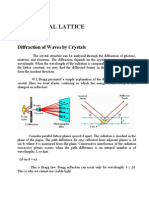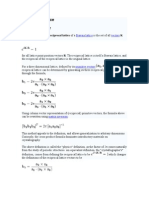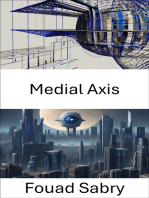0 ratings0% found this document useful (0 votes)
Brillouin Zones
Brillouin Zones
Uploaded by
Saran AyyappanK-space refers to the space of all possible wave vectors that can exist in a crystal lattice. These wave vectors can be represented as points in 3D reciprocal lattice space. Brillouin zones are regions of k-space that identify and classify the allowed wave vectors in a crystal lattice. The first Brillouin zone contains all possible wave vectors allowed by the lattice's symmetry. Higher order Brillouin zones are defined by repeating the process with points at the corners of the first zone. Brillouin zones are useful for understanding electron and phonon behavior in crystals.
Copyright:
© All Rights Reserved
Available Formats
Download as PDF, TXT or read online from Scribd
Download as pdf or txt
Brillouin Zones
Brillouin Zones
Uploaded by
Saran Ayyappan0 ratings0% found this document useful (0 votes)
K-space refers to the space of all possible wave vectors that can exist in a crystal lattice. These wave vectors can be represented as points in 3D reciprocal lattice space. Brillouin zones are regions of k-space that identify and classify the allowed wave vectors in a crystal lattice. The first Brillouin zone contains all possible wave vectors allowed by the lattice's symmetry. Higher order Brillouin zones are defined by repeating the process with points at the corners of the first zone. Brillouin zones are useful for understanding electron and phonon behavior in crystals.
Copyright
© © All Rights Reserved
Available Formats
PDF, TXT or read online from Scribd
Share this document
Did you find this document useful?
Is this content inappropriate?
K-space refers to the space of all possible wave vectors that can exist in a crystal lattice. These wave vectors can be represented as points in 3D reciprocal lattice space. Brillouin zones are regions of k-space that identify and classify the allowed wave vectors in a crystal lattice. The first Brillouin zone contains all possible wave vectors allowed by the lattice's symmetry. Higher order Brillouin zones are defined by repeating the process with points at the corners of the first zone. Brillouin zones are useful for understanding electron and phonon behavior in crystals.
Copyright:
© All Rights Reserved
Available Formats
Download as PDF, TXT or read online from Scribd
Download as pdf or txt
0 ratings0% found this document useful (0 votes)
Brillouin Zones
Brillouin Zones
Uploaded by
Saran AyyappanK-space refers to the space of all possible wave vectors that can exist in a crystal lattice. These wave vectors can be represented as points in 3D reciprocal lattice space. Brillouin zones are regions of k-space that identify and classify the allowed wave vectors in a crystal lattice. The first Brillouin zone contains all possible wave vectors allowed by the lattice's symmetry. Higher order Brillouin zones are defined by repeating the process with points at the corners of the first zone. Brillouin zones are useful for understanding electron and phonon behavior in crystals.
Copyright:
© All Rights Reserved
Available Formats
Download as PDF, TXT or read online from Scribd
Download as pdf or txt
You are on page 1/ 4
Brillouin Zones
K-space:
In a crystal lattice, "k-space" refers to the space of all
possible wave vectors (k-vectors) that can exist in the
lattice. These wave vectors can be represented as points
in a 3D space, and the collection of all these points is
known as the "reciprocal lattice".
In other words, k-space is a mathematical construct that
allows us to represent the properties of a crystal lattice
in terms of the wave vectors that can exist within it. It is
a useful tool for understanding the behavior of
electrons in a crystal, as well as the properties of lattice
vibrations (phonons) and other phenomena.
Brillouin Zones:
Brillouin zones are regions of k-space that are used to
identify and classify the allowed wave vectors (k-
vectors) in a crystal lattice. They are named after the
French physicist Léon Brillouin, who introduced the
concept in the early 20th century.
In a crystal lattice, the allowed wave vectors are
determined by the symmetry of the lattice and the
periodicity of the atomic arrangement. The Brillouin
zones are defined as the regions of k-space that
contain all possible wave vectors that are allowed by
the symmetry of the lattice.
The first Brillouin zone is the region of k-space that
contains all possible wave vectors that are allowed by
the symmetry of the lattice. Higher-order Brillouin
zones can be defined by repeating this process with the
points that are at the corners of the higher-order zones.
Brillouin zones are useful for understanding the
behavior of electrons in a crystal, as well as the
properties of lattice vibrations (phonons) and other
phenomena. They are also important for understanding
the properties of materials and predicting their behavior
under different conditions.
Draw Brillouin Zones:
To draw Brillouin zones, you will need to start with a
basic understanding of the reciprocal lattice.
The reciprocal lattice is a mathematical construct that is
derived from the position of the atoms in a crystal
lattice. It is defined as the set of all possible wavevectors
(k-vectors) that can exist in a crystal lattice. These
wavevectors can be represented as points in a 3D
space, and the reciprocal lattice is the collection of all
these points.
To draw the Brillouin zones, you will need to consider
the reciprocal lattice of a crystal and identify the points
that are at the corners of the Brillouin zones. These
points are known as the "Brillouin zone boundaries".
Once you have identified the Brillouin zone boundaries,
you can draw the Brillouin zones by connecting the
points on the boundaries to form the faces of a
polyhedron. The resulting shape is known as the "first
Brillouin zone".
You can also draw the higher-order Brillouin zones by
repeating this process with the points that are at the
corners of the higher-order Brillouin zones.
You might also like
- The Man of The House by Frank O'connor Analysis100% (7)The Man of The House by Frank O'connor Analysis3 pages
- More Reciprocal Space: Andrew Baczewski PHY 491, October 12th, 2011No ratings yetMore Reciprocal Space: Andrew Baczewski PHY 491, October 12th, 201119 pages
- Band Theory of The Electronic Properties of Solids4No ratings yetBand Theory of The Electronic Properties of Solids411 pages
- No. of Atom, Packing Fraction, Co-Ordination Number - 08.6.22No ratings yetNo. of Atom, Packing Fraction, Co-Ordination Number - 08.6.2247 pages
- Crystal Structures and X-Ray DiffractionNo ratings yetCrystal Structures and X-Ray Diffraction5 pages
- Gresch-Soluyanov2018 Chapter CalculatingTopologicalInvarianNo ratings yetGresch-Soluyanov2018 Chapter CalculatingTopologicalInvarian30 pages
- Unit - Ii Crystalstructure Analysis: - Analysis of Diffraction Patterns - Inter Planer SpacingNo ratings yetUnit - Ii Crystalstructure Analysis: - Analysis of Diffraction Patterns - Inter Planer Spacing29 pages
- Structural Units of Starch Determined by X-Ray Crystal Structure MethodNo ratings yetStructural Units of Starch Determined by X-Ray Crystal Structure Method20 pages
- Physical Chemistry Official Material PDFNo ratings yetPhysical Chemistry Official Material PDF248 pages
- Https - Myguru - Upsi.edu - My - Documents - 2019 - Courses - SFT3053 - Material - K00926 - 20191001220515 - Chapter 2 FLS PDFNo ratings yetHttps - Myguru - Upsi.edu - My - Documents - 2019 - Courses - SFT3053 - Material - K00926 - 20191001220515 - Chapter 2 FLS PDF46 pages
- Crystal Physics: T.Y.Bsc Solid State Physics Unit 1No ratings yetCrystal Physics: T.Y.Bsc Solid State Physics Unit 139 pages
- Crystal Structure - Wikipedia, The Free EncyclopediaNo ratings yetCrystal Structure - Wikipedia, The Free Encyclopedia13 pages
- Medial Axis: Exploring the Core of Computer Vision: Unveiling the Medial AxisFrom EverandMedial Axis: Exploring the Core of Computer Vision: Unveiling the Medial AxisNo ratings yet
- Liz Banks Liz Banks Liz Banks Liz Banks: DucationNo ratings yetLiz Banks Liz Banks Liz Banks Liz Banks: Ducation5 pages
- Konstruk Alat Ukur Adaptasi Lingkungan: Muhliansyah, Anindya Pinasthi Putri, Miranti Rasyid, M. Ali Adriansyah, DianaNo ratings yetKonstruk Alat Ukur Adaptasi Lingkungan: Muhliansyah, Anindya Pinasthi Putri, Miranti Rasyid, M. Ali Adriansyah, Diana8 pages
- JPWP Mark Scheme SPM 2008 Trial Add Maths P1No ratings yetJPWP Mark Scheme SPM 2008 Trial Add Maths P16 pages
- Lesson Plan Class 7th New Kings and Kingdoms100% (2)Lesson Plan Class 7th New Kings and Kingdoms2 pages
- I.Objectives: Arrests-5-People-Over-Bdo-HackingNo ratings yetI.Objectives: Arrests-5-People-Over-Bdo-Hacking3 pages
- Caribbean Studies Data Collection Sources Sample0% (1)Caribbean Studies Data Collection Sources Sample3 pages
- El Buen Matrimonio - Dr. George MorelliNo ratings yetEl Buen Matrimonio - Dr. George Morelli169 pages
- Veverka Planning Interpretive WalkingtoursNo ratings yetVeverka Planning Interpretive Walkingtours9 pages
- More Reciprocal Space: Andrew Baczewski PHY 491, October 12th, 2011More Reciprocal Space: Andrew Baczewski PHY 491, October 12th, 2011
- Band Theory of The Electronic Properties of Solids4Band Theory of The Electronic Properties of Solids4
- No. of Atom, Packing Fraction, Co-Ordination Number - 08.6.22No. of Atom, Packing Fraction, Co-Ordination Number - 08.6.22
- Gresch-Soluyanov2018 Chapter CalculatingTopologicalInvarianGresch-Soluyanov2018 Chapter CalculatingTopologicalInvarian
- Unit - Ii Crystalstructure Analysis: - Analysis of Diffraction Patterns - Inter Planer SpacingUnit - Ii Crystalstructure Analysis: - Analysis of Diffraction Patterns - Inter Planer Spacing
- Structural Units of Starch Determined by X-Ray Crystal Structure MethodStructural Units of Starch Determined by X-Ray Crystal Structure Method
- Https - Myguru - Upsi.edu - My - Documents - 2019 - Courses - SFT3053 - Material - K00926 - 20191001220515 - Chapter 2 FLS PDFHttps - Myguru - Upsi.edu - My - Documents - 2019 - Courses - SFT3053 - Material - K00926 - 20191001220515 - Chapter 2 FLS PDF
- Crystal Physics: T.Y.Bsc Solid State Physics Unit 1Crystal Physics: T.Y.Bsc Solid State Physics Unit 1
- Crystal Structure - Wikipedia, The Free EncyclopediaCrystal Structure - Wikipedia, The Free Encyclopedia
- Medial Axis: Exploring the Core of Computer Vision: Unveiling the Medial AxisFrom EverandMedial Axis: Exploring the Core of Computer Vision: Unveiling the Medial Axis
- Konstruk Alat Ukur Adaptasi Lingkungan: Muhliansyah, Anindya Pinasthi Putri, Miranti Rasyid, M. Ali Adriansyah, DianaKonstruk Alat Ukur Adaptasi Lingkungan: Muhliansyah, Anindya Pinasthi Putri, Miranti Rasyid, M. Ali Adriansyah, Diana





























































































